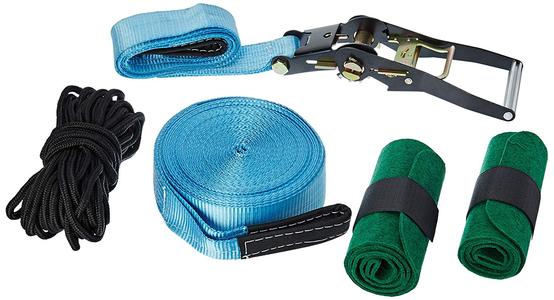Item No :
SL001Order(MOQ) :
1Payment :
30% deposit, 70% pay after receiving BL copyProduct Origin :
ChinaColor :
Any ColorShipping Port :
Nanjing/ShanghaiLead Time :
15-45daysBrand :
D.L.T SLING


The two-section setup consists of: a long (30–100-foot, 9–30-metre) piece of two-or-one-inch (5.1 or 2.5 cm) webbing with a loop sewn on one end, allowing it to cinch tightly around a tree. The second section is typically much shorter (10 ft, 3 m) and has a similar sewn loop on one end, allowing it to cinch around a tree while the other end of this shorter piece of webbing is sewn to a ratchet. The ratchet allows these two sections of webbing to be connected and tensioned to the user's specifications.
The three-section setup consists of: a long section of webbing (30–100 ft, 9–30 m) strung tightly and connected to two shorter sections (8–12 ft, 2.5–3.5 m) that are called "tree slings" and are used as anchors on either end. The most difficult and widely discussed element of a slackline setup is the tensioning system. Common setups include simple friction methods (which can also be set up with a single section of webbing), using wraps of webbing between two carbiners, a ratchet, a comealong, a carabiner pull system, a roped pulley system, or a commercial slackline kit.
The most common anchors for slacklines are trees. Trees greater than 12 inches (30 cm) in diameter are considered ideal in most cases. There are several very effective methods of tree protection that function on two principles: eliminating abrasion, and redistributing the load over a wider area. One of the most effective means of tree protection is a wrap of vertical blocks (1 in × 1 in (2.5 cm × 2.5 cm) cut into 6 in (15 cm) pieces) strung together by drilling a small-diameter hole through the center and running cord through them. Blocks are spaced evenly to prevent the anchor slings from contacting and abrading the outer bark, and the length of the blocks distributes the load vertically as opposed to horizontally, compressing a continuous line around the trunk. The addition of a carpet square between the block wrap and the outer bark is considered ideal among the founding community of slackliners. Many other ways to protect the tree are commonly used, such as towels, mats, cardboard, carpet and purpose-made tree protectors.
Using carpet squares or cardboard even, by themselves, addresses only abrasion, leaving the load concentrated on a small area of the tree. These methods are adequate for occasional use, but with the high tension of longlines, one who slacklines regularly should take every precaution to protect the life of the tree.